Cat grass: why it is needed and how to grow it at home
The diet of a domestic cat must be supplemented with healthy foods, among which greens stand out. Owners often notice what a magnetic property indoor flowers and plants on their property have for their pets. You can grow grass for cats from special seeds at home. It's fast, easy and inexpensive.
Why do cats need grass?
Wild cats eat greens regularly, while the diet of domestic cats is limited. This situation needs to be corrected, because grass is really necessary for cats, and here’s why:
- Animals lick their fur daily. As a result, a certain amount of villi enters the stomach. The herb has an irritant effect and helps induce vomiting to prevent hair from accumulating in the body.
- Also, the gag reflex helps the cat if she has eaten something wrong or overeat. With the help of green shoots, your pet will quickly get rid of the remains of undigested food.
- This is how wild cats supplement their diet. Greens contain beneficial B vitamins, particularly folic acid. The animal needs it to grow.
- The plant has a strengthening effect on the intestines.
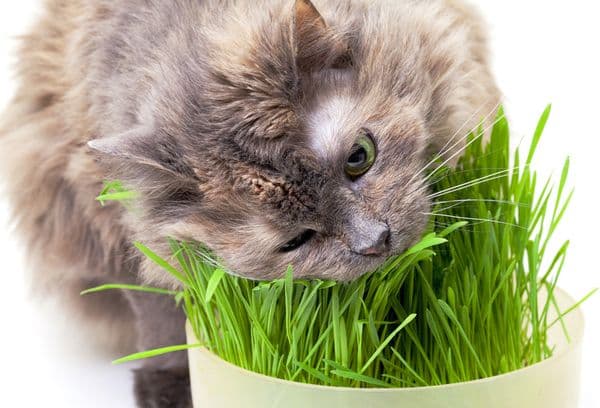
Another reason is that animals simply like the taste of greens. They can bite grass without swallowing it. Some pets play like this. Houseplants often suffer from such habits. Scolding a cat, especially an adult, in such cases is useless. To shift the focus away from flowers, simply plant some cat grass seeds and make them available.
What grass is grown for cats?
Not every herb will be useful to the animal; some types threaten poisoning. Always be careful when choosing indoor plants. Flowers such as ficus benjamina, anthurium, begonia, and geranium are toxic.
You cannot take grass from the street, even if the animal wants to try it on a walk. Such greenery is too polluted, especially within the city, and may contain parasite larvae. It is better to grow the grass cleanly yourself.
Garden supply stores sell special grass seeds. for cats. They are cheap and easy to grow. It is a good idea to plant other crops such as oats, barley, wheat and rye. Pets really like the green shoots of these cereals.
Another option is to buy already sprouted grass at a pet store.
We grow in the ground
To grow, you will need a pack of seeds, soil and a small container. The usual composition for germinating flowers, such as orchids, is suitable as soil. The soil is best light, not overloaded with fertilizers. Seeds grow well in any soil and even without it, because they do not need special nutrition for flowering and fruiting.
What container should I use for grass? There are no special requirements here either. Any deep plate, flower pot, seedling box, or even a new cat litter box will do. The shoots will grow beautifully through the mesh.
How to grow cat grass, all stages:
- Before planting, seeds are soaked for an hour in warm water. This will speed up their germination.
- The container is filled with soil, but not to the very top.
- The prepared seeds are poured onto the ground.
- They are covered with a thin layer of earth on top.
- Seeds can also be grown in vermiculite. To do this, the substrate is soaked for an hour along with the planting material.
- Seeds planted in the soil are moistened; vermiculite can simply be sprinkled with water.
- Now you need to create a greenhouse effect. The growing pot is covered with transparent cling film. You can use a plastic bag.
- In order for the grass to hatch, it is moved to a warm place, for example, near a radiator.
- After just 2-3 days, the first sprouts of grass will appear above the ground. The greenhouse is removed only after 4-5 days. Moisten the substrate in a timely manner.
- The pet is given a treat to chew on a week after boarding. It is advisable for the cat to eat greens directly from the garden. A torn shoot quickly withers.
- You need to sow the seeds once a week, then the animal will be constantly supplied with a vitamin supplement.
Advice! Monitor the amount of greens your pet eats. If you cannot tear the cat away from the garden bed, it is better to consult a veterinarian, as there may be problems with digestion. If your pet doesn't eat a treat, don't force it.
Method without soil
Cat grass seeds germinate well even without soil. For this method, gauze or bandage is used.
How to grow grass on cheesecloth:
- Take a plastic container and make drainage holes at the bottom.
- Before germination, seeds are soaked in warm water for 1-2 hours.
- The gauze is folded into 2-3 layers and moistened.
- Line the bottom of the plate with gauze, place the seeds on top and cover with another layer of damp gauze.
- Keep the container in a warm place, periodically adding water.
The magazine purity-en.htgetrid.com advises buying seeds only in special departments. In the markets you may find low-quality material treated with chemicals.
Grass toys
It will be interesting for a small kitten to play with a figurine from which greenery grows. It can be any object made of fabric - a person, an animal, etc.It’s easy to sew a toy with your own hands, for example, from an old nylon sock. Cat grass seeds and sawdust are placed inside. The contents are moistened, then the fabric is stitched. The grass will sprout if you regularly soak the fabric with warm water.
Take the time to grow your cat's green treats yourself. Your pet will appreciate it!
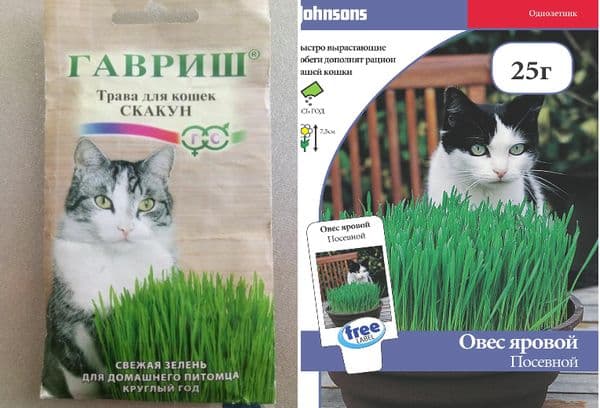
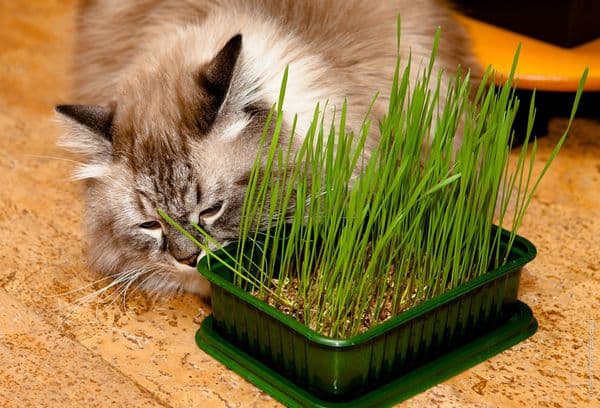
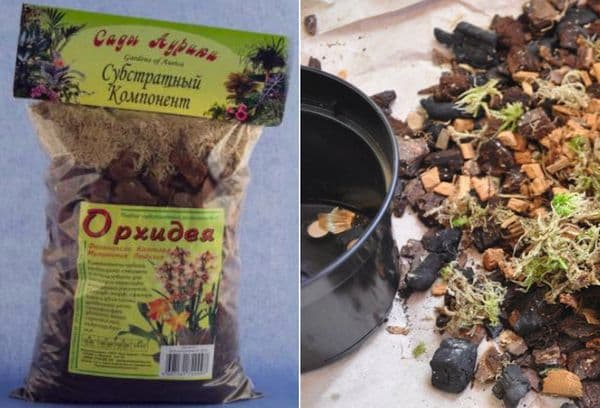
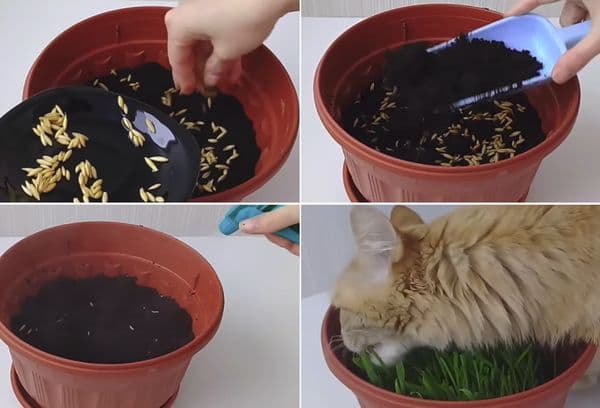
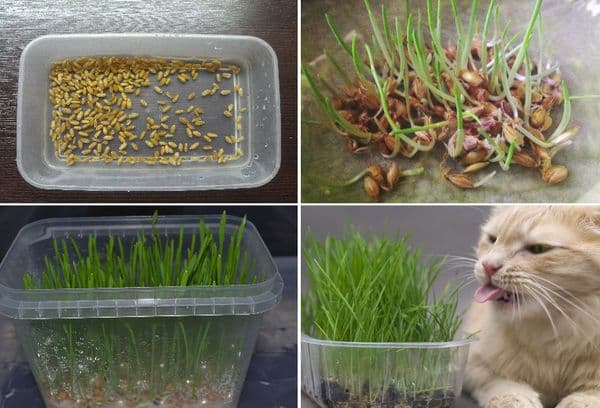
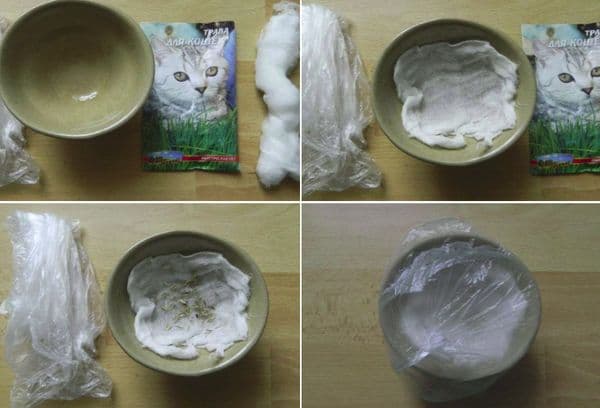
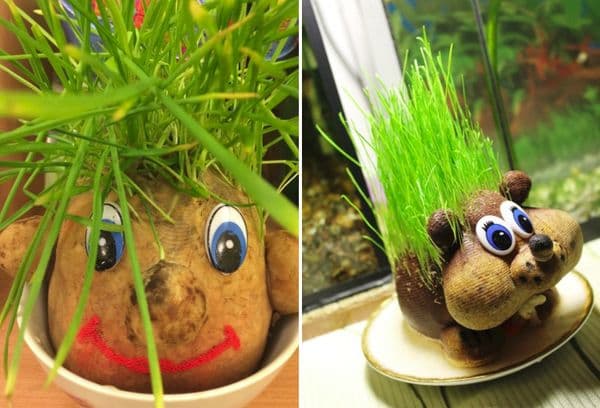
It is best to grow in a 0.7-1 liter pot (plastic, with a drainage hole in the bottom, sold in Magnit or Pyaterochka), oat seeds "BAKA" - food for parrots, sold in a pet store, soil without fertilizers, sold in flower shops. We fill the soil to 2/3 of the volume of the pot, compact it a little, pour it well with hot water, pour the seeds so as to cover the soil, a little earth on top, compact it slightly and pour it with warm water, put on a plastic bag and leave it alone for two days, remove the bag and Water lightly and it’s ready in a day. The whole process takes 3-4 days, enough for a cat for 3-4 days.This method is three times cheaper than buying a ready-made kit at a pet store, especially since a kit for growing grass is not practical for cats; the cat will destroy it the first time (a very light tray).
There has always been such a problem - they bite it while it’s not yet grown and, moreover, they pull it out along with the roots and sawdust. I buy it ready-made - how beautiful everything is from them, you can’t tear it out by the roots. I tried many different methods - the result is the same - the shoots are heterogeneous, where it is empty, where it is thick, they are torn out with roots and sawdust, everything is scattered throughout the kitchen... young shoots are torn out, if you do not have time to stick them back, they dry out. I came up with my own way, the goal was achieved, the result is +!!!! I soak 2/3 cup of seeds in a jar for a day. There are always a lot of them that float up, so I throw them away. I moisten about two cm of sawdust and tamp it firmly with a spoon into a store-bought backing. I lay the seeds tightly with my hands and completely, probably about 2 layers of seeds. I covered the top with sawdust, less than 1 cm. And here is my invention: I cover the substrate with GAUZE, AND ON TOP I tie the entire bed with thread several times, as if “bandaging”. This is exactly what the substrate is needed for - its height and the height of the sawdust are approximately the same. The result is rated “excellent”. Keep in mind that as the plant germinates and grows, the height of the bed will increase slightly. I have a photo, but I don't know how to attach it. There are no pulled out pieces of grass and sawdust lying all over the kitchen)))).
I grew grass in the ground, in a pot. At first I had to hide it until the grass grew up. But now there is a lot of grass, the cat doesn’t eat it all at once, and it grows again.